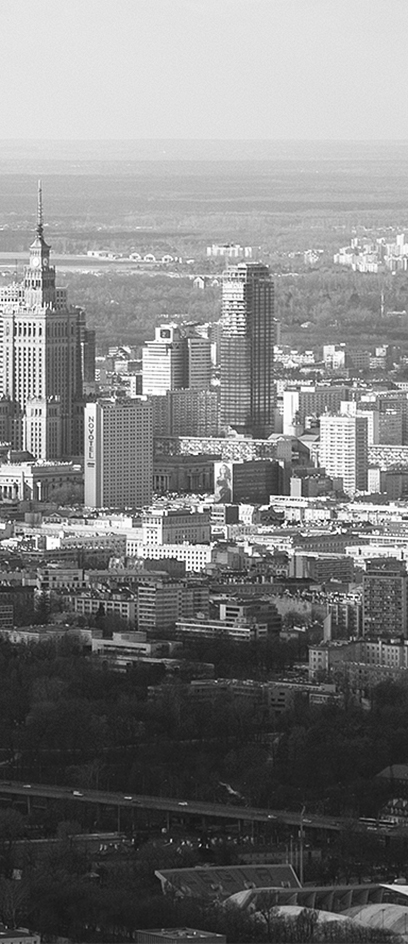 Warszawa
Warszawa
the capital of Poland
The origins of Warsaw are shrouded in mystery. It is known that originally (during the tenth and eleventh centuries), in what is now the Polish capital, there were several minor, independent settlements, such as Old Bródno, Jazdów, Solec or Kamion. The early settlers made their living through salt trade and conducing crossings over the Vistula River, among other activities.
The earliest mention of Warsaw (then known under the name Warszowa or Warszewa) comes from the year 1313. It is believed that around that time the town was established on the Vistula embankment in the today's location of the Royal Castle and the Old Town.
From the fourteenth century, political significance of Warsaw gradually increased. The dukes of Mazovia governed from the city. One hundred years later, Warsaw was made the capital of the Duchy of Mazovia and in 1526, it became part of the united Polish Kingdom.
In the second half of the sixteenth century Warsaw was home to sessions of parliament as well as elections of Polish kings. In 1596 the current King Zygmunt III Waza decided to move his own court here from Kraków own, which some deem a symbolic gesture of giving Warsaw the rank of capital. Actually, Warsaw is defined as the official capital of Poland only in eighteenth-century documents.
The “Royal” Warsaw entered a period of accelerated development. Anyone who wanted to be close to the king settled here. From the seventeenth century, Warsaw streets began to be colonized by the representatives of the nobility, the aristocracy and the clergy. This is the way in which today's well-known main streets evolved, including today's Krakowskie Przedmieście. The dynamic growth of the city lasted until the end of the eighteenth century, despite temporary conflicts and disasters of war – such as the Swedish invasion of 1655-1656 and the struggle for the Polish succession between 1733 and 1738. During the reign of the last king of Poland, Stanisław August Poniatowski most of the intellectual elite of the country gathered in Warsaw; it was here that the first schools, operas and theatres were created.
When in 1795 Poland disappeared from the map after its final partition, Warsaw became part of the Kingdom of Prussia. In 1806 with the help of Napoleon an independent Duchy of Warsaw was created, but its downfall came soon enough. Since 1815 the city was closely linked to the Russian rule, and the local population was subjected to russification. The architecture underwent changes and Polish shop signs gave way to Russian. This condition lasted until Poland regained its independence in 1918.
In the years between two world wars, Warsaw experienced a renaissance and flourished again. The city again began to teem with life, becoming a showcase of the reborn country. A number of new investment projects were carried out in the capital - the building of the National Museum, Parliament building at Wiejska street as well as a number of modern residential areas, transportation routes and rail tracks.
All that was gained in these twenty years was quickly annihilated when in 1939 World War II broke out. Warsaw area came under German occupation, a large part of the city fenced in by a wall, behind which was a Jewish ghetto was created. The streets were systematically destroyed, and with them valuable material culture, starting with the Royal Castle and the Old Town. According to the plans of Hitler, Warsaw was to be wiped out, and a new German town was to be erected in its place.
As a result of the demolition and fighting during the war (mainly during the Warsaw Uprising in 1944) approximately 85% of the urban construction in Warsaw was destroyed. Rebuilding began immediately after the war. A specially appointed body - Biuro Odbudowy Stolicy (The Office of Reconstruction of the Capital) was responsible for coordinating all activities designed to bring Warsaw back to life. Thanks to numerous donations of residents from across Poland and the generosity of Varsovians, in less than ten years most of the buildings, monuments and infrastructure were rebuilt. At the same time new investments we realized, for example Trasa W-Z (East-West Route) which was built underneath the Castle Square or the Palace of Culture and Science - one of the symbols of modern capital.
The entire period between 1945 and 1989 in Warsaw, despite often poor policies of the communist authorities, was marked by a number of ambitious projects. During that time a number of projects were built among them, Central Train Station, Łazienkowska Route and the beginning of the metro construction. New developments saw the light of day, and even entire residential districts (including Ursynów). Warsaw also went through a number of territorial expansions, and today its area covers up to 517 square kilometres.
Modern Warsaw is a medium sized European metropolis, inhabited by about 1.7 million people. Including those not registered and residents of towns near Warsaw, the capital city metropolitan area has more than 3 million people. This is an impressive result not only in the country but also for the whole of Central and Eastern Europe. It can not therefore be surprising that the city is still growing (especially after 1989), attracting investors from around the world.






